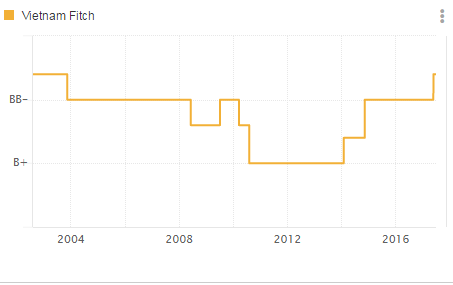According to the general method, before making a statement and assessment of the situation and prospects of the commercial banking system, credit rating agencies begin with an assessment of the macroeconomic environment
What are credit rating agencies “thinking" about the banking system of Vietnam?
According to the general method, before making a statement and assessment of the situation and prospects of the commercial banking system, credit rating agencies begin with an assessment of the macroeconomic environment which plays as a platform of banking operations.
In general, these rating agencies have a positive assessment of Vietnam's macroeconomic environment now and during the time of next one or two years. Emerging positive factors include high economic growth backed by strong FDI inflows and positive export growth, while inflation has been kept under control.
Some credit rating agencies say that positive factors include the relatively stable domestic currency and good domestic consumption, while others comment that although the TPP has collapsed, causing Vietnam to lose a chance to promote economic growth but this was offset by the wave of FDI flowed into before that time, so the breakdown of the TPP did not cause much damage for Vietnam.
In addition to the positive reviews, the ranking also points out some negative points about the macro environment, including the level of debt of the economy in general and of the Government in particular is high and in the continuing rise, despite the Government's fiscal consolidation efforts, has put pressure on the government's macroeconomic stabilization policy including curbing inflation and stabilizing the exchange rate.
Regarding the health of the commercial banking system, the rating agencies have some similar comments. Specifically, the normal credit growth (16% -18% per year, equal to 1.2 times to 1.5 times GDP growth at current price, depending on the standard of each firm) in the context of not raising the risk for the growth of the banking system, credit growth target of over 20% is "too fast", even worrying.
Explaining the concerns about high credit growth, credit rating agencies say that high credit growth in the context of rising debt burdens will create more challenges, including formation of asset bubbles, the bank's capital base continues to weaken from its current low level compared to the region, bank margins continue to shrink as banks struggle fiercely and keep market share, and credit is continued to pour into high-risk areas such as real estate speculation, securities etc.
In terms of asset quality, reflected in the bad debt ratio, agencies generally have to re-evaluate the bad debt ratios of the banks they rated in Vietnam by including the bad debt reported by Banks value of the bonds that they have sold VAMC as well as including the outstanding loans classified in the "special attention" category. The actual non-performing loans ratio counted by them is higher than the level of 3% of the majority of banks reported on the books.
With high credit growth this year and possibly next years, on the one hand, this will help reduce bad debt ratio. But on the other hand, high credit growth will tend to generate more bad debt (due to more subprime lending and subprime borrowing) and eventually create uncertainty about bad debt ratios. It is not necessary that bad debt ratio will be reduced this year and next years despite the recent efforts to solve bad debt. In general, firms expect the NPL ratio in Vietnam to be stable or only slightly down in the near future.
Low profit growth, which is not commensurate with Vietnam's GDP growth, is also indicated as one of the negative points in Vietnam's banking system. Factors that negatively affect profit growth include high risk provisioning and fierce competition for market share among banks, which narrowed banks' margins.
Regarding profit prospects in the coming years, the rating agencies generally comment that Vietnamese banks are actively promoting retail and consumer lending in the context that large enterprises and state-owned enterprises have too much debt, it is difficult to promote additional loans. This trend will help improve profit margins of Vietnamese banks.
However, rating agencies also noted that because retail and consumer loans are generally to be unmortgaged or mortgaged by real estate, lending to these sectors is likely to increase bad debt if risk management is not well enforced. They further warned that because lending to these areas is a development strategy at many banks, this has led to increased competition, putting pressure on banks' next years. At the same time, rapid credit growth in parallel with boosting lending to more risky areas such as consumer lending will create more bad debt and should force banks to increase their bad debt provision. It will limit the level of profitability improvement of banks.
- The young knowledge-























































